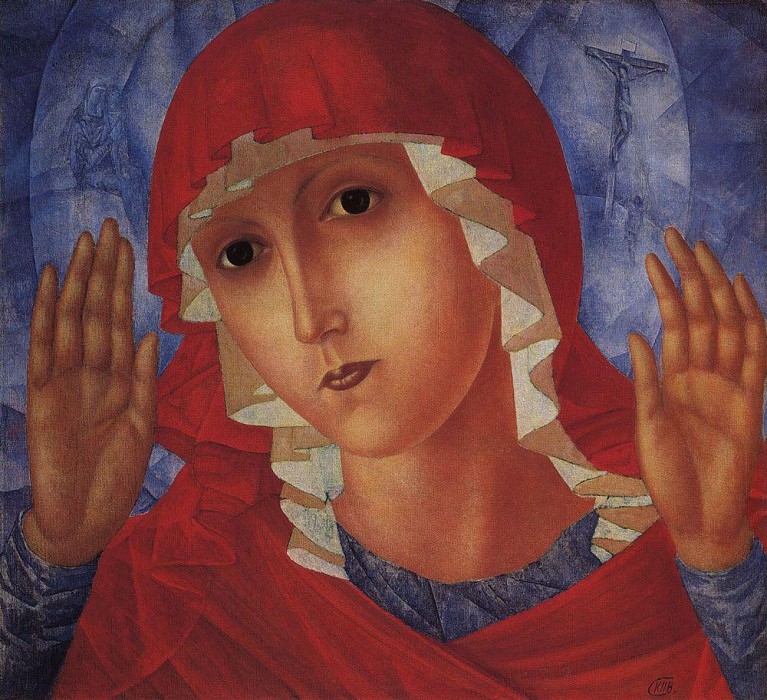Virgin of Tenderness evil hearts. 1914-1915 Kuzma Sergeevich Petrov-Vodkin (1878-1939)
Kuzma Sergeevich Petrov-Vodkin – Virgin of Tenderness evil hearts. 1914-1915
Edit attribution
Download full size: 1000×913 px (0,2 Mb)
Painter: Kuzma Sergeevich Petrov-Vodkin
Location: State Russian Museum, St. Petersburg (Государственный Русский Музей).
Kuzma Sergeyevich Petrov-Vodkin is without a doubt one of the most famous artists. This Soviet and Russian painter contributed greatly to the development of drawing, painting, and pedagogy. In 1930, Petrov-Vodkin was recognized as a Distinguished Artist. His paintings were influenced by many foreign creators. The artist’s paintings bear the imprint of modernism and symbolism. Throughout his life Kuzma Sergeyevich created many portraits, still lifes and thematic works. The artist received considerable experience of religious images earlier, during the painting of the walls of the church at the Orthopedic Institute in St.
Description of Kuzma Petrov Vodkin’s painting "Our Lady of Pleasing the Wicked Hearts
Kuzma Sergeyevich Petrov-Vodkin is without a doubt one of the most famous artists. This Soviet and Russian painter contributed greatly to the development of drawing, painting, and pedagogy. In 1930, Petrov-Vodkin was recognized as a Distinguished Artist. His paintings were influenced by many foreign creators. The artist’s paintings bear the imprint of modernism and symbolism. Throughout his life Kuzma Sergeyevich created many portraits, still lifes and thematic works.
The artist received considerable experience of religious images earlier, during the painting of the walls of the church at the Orthopedic Institute in St. Petersburg. Then the master took part in decorating the walls of the cathedral located in Kronstadt. The temple in Suma is also painted by his hand. Church activities influenced the perception of Petrov-Vodkin. In 1915, he finished his work on the image of the Mother of God in the image of a simple peasant woman breastfeeding her child. The painting was titled "Mother."
"Our Lady of the Pleasing of the Wicked Hearts" was created by the author during the First World War in 1915. Its title echoes the notion of the iconography of the Russian Orthodox Church "Softening of the Evil Hearts". The painting bears the imprint of the tragic wartime events for the country and the people. Despite its relatively small size, the painting is a monumental example of painting. The Mother of God on the canvas covered her head with a red kerchief. Her palms bear soothing and blessing.
On the left side of the painting is a silhouette of the Virgin and Child. To the right is Jesus Christ on the crucifixion. The disturbed, reverent, compassionate image is one of the strongest such masterpieces, affecting the emotions and feelings of the viewer.
Кому понравилось
Пожалуйста, подождите
На эту операцию может потребоваться несколько секунд.
Информация появится в новом окне,
если открытие новых окон не запрещено в настройках вашего браузера.
You need to login
Для работы с коллекциями – пожалуйста, войдите в аккаунт (open in new window).




















COMMENTS: 3 Ответы
Почему нигде не пишут что эта картина является даром коллекционера Окунева Бориса Николаевича Русскому музею". Хоть их (Бориса Николаевича, Наталии Николаевны – жены и Киры Борисовны – дочери) уже нет на этом свете, не стоит русскому музею забывать откуда появились в собрании 300 картин. Тем более что живы родственники.
Я не застал самого Бориса Николаевича, но прекрасно помню двух очаровательных дам – Н. Н. и К. Б. Окуневых – которые знакомили нас с огромной коллекцией, развешанной по всем углам петербургской квартиры. "Богоматерь" висела в гостиной, прямо над огромным обеденным столом и темными деревянными стульями с резным орнаментом на высоких спинках. Хозяйки накрыли стол (была прекрасная паровая курица и тертая свекла), но я не мог ни на что смотреть, кроме как на эту картину. Коллекция была уже описана, судьба картин – предопределена. Жаль, что на сайте ГРМ не нашлось места для известной фамилии Окуневых.
Информация об Окуневых добавлена в статью "Богоматерь Умиление злых сердец" в русской Википедии. https://ru. wikipedia. org/w/index.php? title=%D0%91%D0%BE%D0%B3%D0%BE%D0%BC%D0%B0%D1%82%D0%B5%D1%80%D1%8C_%D0%A3%D0%BC%D0%B8%D0%BB%D0%B5%D0%BD%D0%B8%D0%B5_%D0%B7%D0%BB%D1%8B%D1%85_%D1%81%D0%B5%D1%80%D0%B4%D0%B5%D1%86&redirect=no#%D0%9F%D1%80%D0%B8%D0%BC%D0%B5%D1%87%D0%B0%D0%BD%D0%B8%D1%8F
You cannot comment Why?
The title, Evil Hearts, is a significant subtext that challenges traditional iconography. Instead of portraying a serene and loving Madonna, Malevich introduces a sense of foreboding and sorrow. The Virgins raised hands, palms outward, can be interpreted in several ways: as a gesture of protection, a plea for mercy, or even a sign of distress and agony.
In the background, faint images hint at tragedy. On the left, a silhouette of figures, possibly a mother and child, can be observed, perhaps alluding to the broader human condition or a prophecy of future suffering. On the right, a dark, abstract representation of the Crucifixion is visible, directly linking the Virgins grief to the ultimate sacrifice. The cubist-like fragmentation of the background further contributes to the overall sense of unease and brokenness, reflecting the turbulent times in which the painting was created (World War I).
Malevichs bold use of color and form, characteristic of his Suprematist style, intensifies the emotional impact. The raw, almost visceral portrayal of the Virgin’s pain and her apprehensive gaze invite the viewer to confront the darker aspects of faith, suffering, and humanitys capacity for both good and evil. This is not a comforting devotional image, but rather a profound meditation on grief, sacrifice, and the inherent tragedy woven into the narrative of faith.